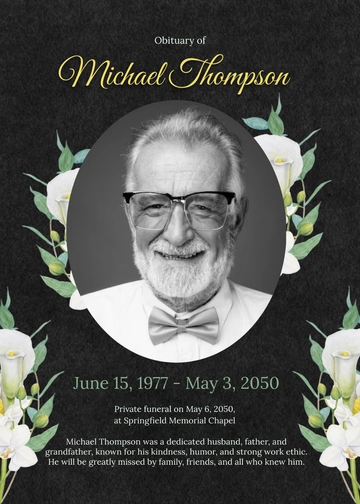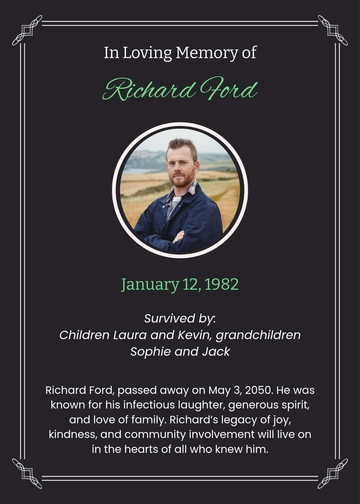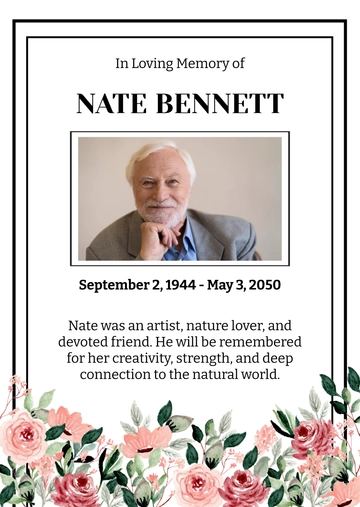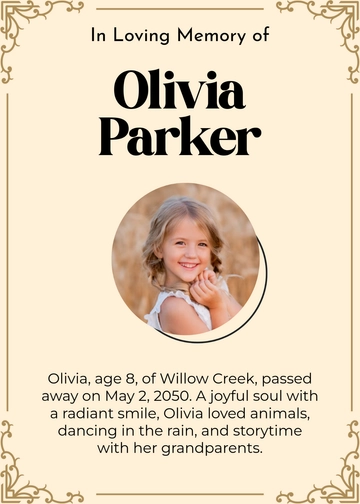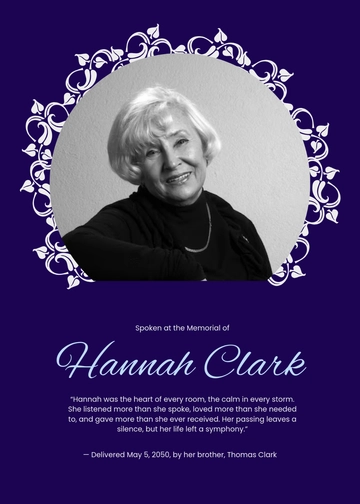Free Obituaries Article
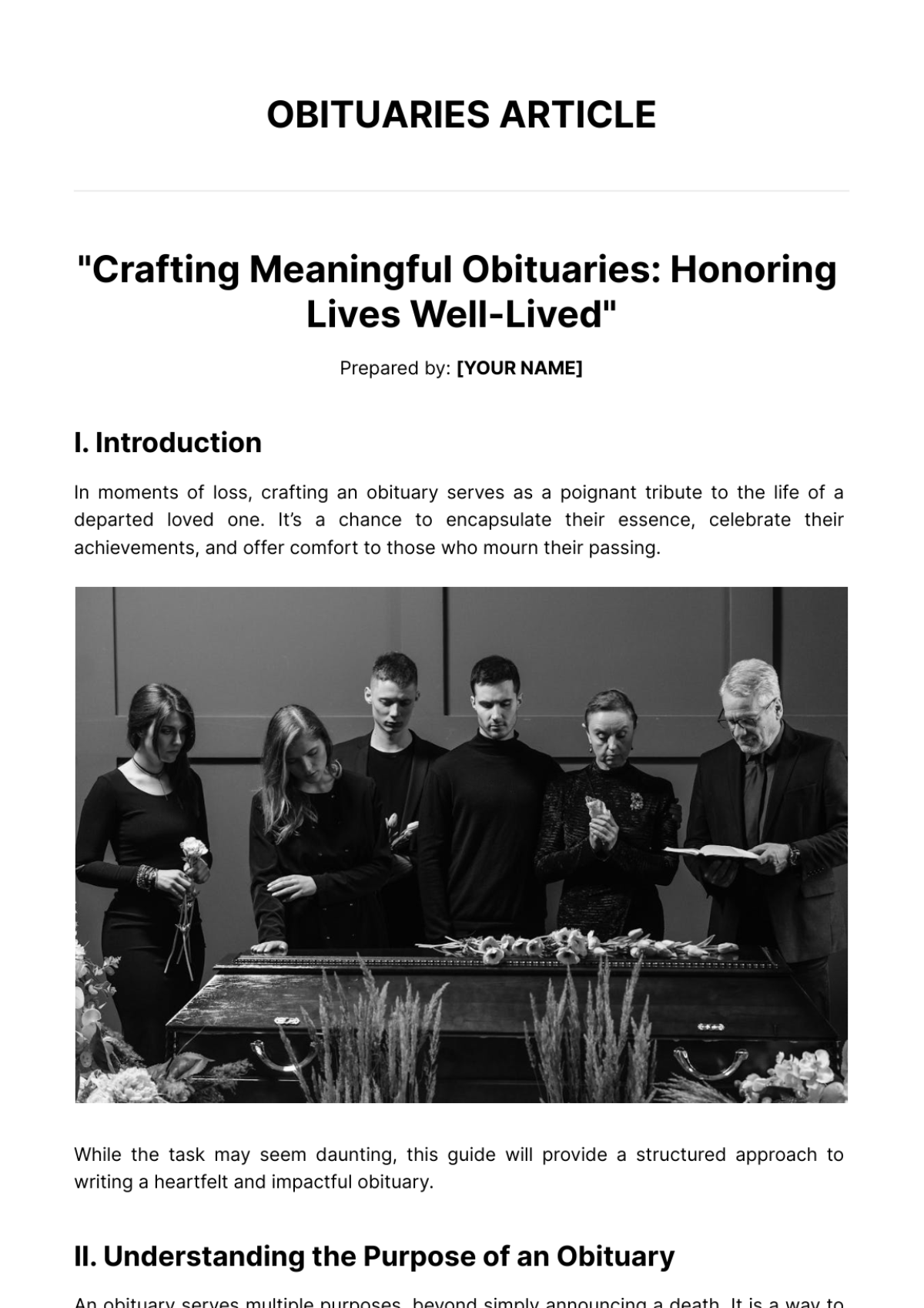
"Crafting Meaningful Obituaries: Honoring Lives Well-Lived"
Prepared by: [YOUR NAME]
I. Introduction
In moments of loss, crafting an obituary serves as a poignant tribute to the life of a departed loved one. It’s a chance to encapsulate their essence, celebrate their achievements, and offer comfort to those who mourn their passing.

While the task may seem daunting, this guide will provide a structured approach to writing a heartfelt and impactful obituary.
II. Understanding the Purpose of an Obituary
An obituary serves multiple purposes, beyond simply announcing a death. It is a way to inform the community, express grief, and celebrate the life of the deceased. Understanding these purposes can help guide the tone and content of the obituary.
"People living deeply have no fear of death." —Anais Nin
III. The Essence of an Obituary
At its core, an obituary serves as a biographical sketch, capturing the essence of the departed individual. It typically begins with basic details such as [DECEASED PERSON'S NAME], [DECEASED PERSON'S AGE], and [DECEASED PERSON'S ADDRESS].

Following this, delve into the individual's life story, highlighting significant milestones, passions, and contributions to their community or profession. Consider including details about their upbringing, education, career, and any notable achievements or awards they may have received.
IV. Structuring Your Obituary
A well-structured obituary is not only informative but also emotionally resonant. Consider the following elements when drafting your obituary:
A. Personal Information:
[DECEASED PERSON'S NAME], [DECEASED PERSON'S AGE], [DECEASED PERSON'S BIRTH DATE] - [DECEASED PERSON'S DEATH DATE], [DECEASED PERSON'S ADDRESS].
Surviving family members: [SPOUSE'S NAME], [CHILDREN'S NAMES].
B. Life Story:
Begin with a brief overview of the individual's life, including where they were born and raised.
Highlight significant milestones, accomplishments, and hobbies that defined their life.
"What you leave behind is not what is engraved in stone monuments but what is woven into the lives of others." —Thucydides
C. Funeral Arrangements:
Provide details about the funeral or memorial service, including date, time, and location.
Mention any requests regarding donations or flowers in lieu of gifts.
D. Remembering Their Legacy:
Share anecdotes, quotes, or stories that exemplify the character and values of the deceased.
Reflect on their impact on the lives of others and their lasting legacy in the community.
E. Expressing Gratitude:
Take a moment to thank those who have supported the family during this difficult time.
Express appreciation for the outpouring of love and condolences from friends, neighbors, and colleagues.
"No one is actually dead until the ripples they cause in the world die away." —Terry Pratchett
V. Capturing the Essence
When writing an obituary, strive to capture the essence of the departed individual.
Use descriptive language that reflects their personality, values, and unique quirks. Share anecdotes or memorable stories that illustrate who they were as a person. Remember, an obituary is not just a factual account of someone's life but a heartfelt tribute that honors their memory.
If you're not careful, obituaries can often lead to identity theft.
VI. Conclusion
In conclusion, writing an obituary is a meaningful way to honor the life of a loved one and provide solace to those who mourn their loss. By following the guidelines outlined in this article, you can create a touching tribute that celebrates the legacy of the departed individual and brings comfort to those who cherish their memory.
- 100% Customizable, free editor
- Access 1 Million+ Templates, photo’s & graphics
- Download or share as a template
- Click and replace photos, graphics, text, backgrounds
- Resize, crop, AI write & more
- Access advanced editor
Elevate your obituary writing with Template.net's Obituaries Article Template. Crafted to streamline your process, this customizable and editable template offers a seamless experience. Designed with an AI Editor Tool, it ensures precision and efficiency, saving you time while maintaining a personal touch. Create heartfelt tributes effortlessly, with every detail perfectly arranged.

